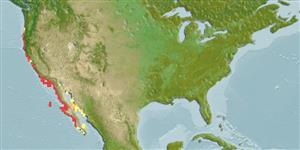Common names from other countries
>
Atheriniformes (Silversides) >
Atherinopsidae (Neotropical silversides) > Atherinopsinae
Etymology: Atherinopsis: Greek, atherina, the Greek name for the eperlane; 1770 + Greek,ops = appearance (Ref. 45335).
More on author: Girard.
Environment: milieu / climate zone / depth range / distribution range
Ecologia
marinhas; intervalo de profundidade ? - 30 m (Ref. 37955). Subtropical; 46°N - 22°N, 129°W - 110°W
Eastern Pacific: Yaquina Bay in Oregon, USA to southwestern coast of Baja California, Mexico.
Tamanho / Peso / Idade
Maturity: Lm ? range ? - ? cm
Max length : 45.0 cm TL macho/indeterminado; (Ref. 9273); common length : 40.0 cm TL macho/indeterminado; (Ref. 9273); Idade máx. registada: 11 anos (Ref. 56049)
Descrição breve
Chaves de identificação | Morfologia | Morfometria
Espinhos dorsais (total) : 6 - 10; Raios dorsais moles (total) : 11 - 14; Espinhos anais: 1; Raios anais moles: 21 - 26; Vértebras: 50 - 54. Branchiostegal rays: 5-6 (Ref. 36497).
Adults inhabit inshore areas, including bays (Ref. 2850). Form schools (Ref. 2850). Demersal spawners in nearshore habitats (Ref. 56049). Oviparous, with planktonic, primarily neustonic larvae (Ref. 36497). Eggs are attached to one another by spawning substrate via adhesive filaments (Ref. 36497). Sold fresh (Ref. 2850).
Eschmeyer, W.N., E.S. Herald and H. Hammann, 1983. A field guide to Pacific coast fishes of North America. Boston (MA, USA): Houghton Mifflin Company. xii+336 p. (Ref. 2850)
Categoria na Lista Vermelha da IUCN (Ref. 130435)
CITES (Ref. 128078)
Not Evaluated
Ameaça para o homem
Harmless
Utilização humana
Pescarias: espécies comerciais
Ferramentas
Relatórios especiais
Descarregue XML
Fontes da internet
Estimates based on models
Preferred temperature (Ref.
115969): 12.8 - 24.2, mean 20.7 (based on 122 cells).
Phylogenetic diversity index (Ref.
82804): PD
50 = 1.0000 [Uniqueness, from 0.5 = low to 2.0 = high].
Bayesian length-weight: a=0.00724 (0.00392 - 0.01338), b=3.01 (2.84 - 3.18), in cm Total Length, based on LWR estimates for this species & (Sub)family-body (Ref.
93245).
Nível Trófico (Ref.
69278): 2.3 ±0.21 se; based on food items.
Resiliência (Ref.
120179): Médio, tempo mínimo de duplicação da população 1,4 - 4,4 anos (tm=2.5; Fec = 6,000).
Fishing Vulnerability (Ref.
59153): Low to moderate vulnerability (35 of 100).
